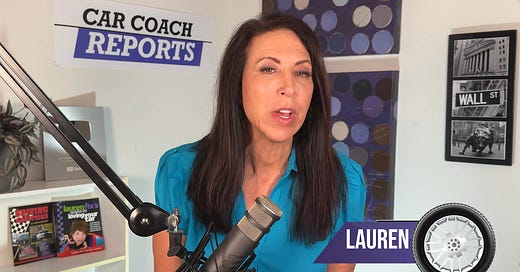Jay Leno’s Push for "Leno’s Law": A Win for Classic Car Lovers in California
By Lauren Fix
If you’ve been keeping an eye on California’s automotive scene, you’ve probably heard the buzz about Senate Bill 712, affectionately dubbed “Leno’s Law.” Yes, that Jay Leno — the comedian, former Tonight Show host, and legendary car collector, he is throwing his weight behind a proposal that could make life a whole lot easier for classic car owners in the Golden State.
As someone who’s spent years analyzing the auto industry, I’ve got to say, this bill has my attention, and it might just be a game-changer for those of us who cherish automotive history. This could be rolled out in other states too. So, let’s dive into what this bill is all about, the criteria it sets, what years it applies to, and whether it’ll shift with time.
"Leno’s Law” is based on California’s smog check rules, which are a bit of a thorn in the side for classic car owners. Since 2005, the state has exempted vehicles from model year 1975 and older from smog tests. That’s great if you’re cruising in a ‘60s muscle car or a ‘50s hot rod, but if your pride and joy is from 1976 or later, you’re stuck bringing it to a smog station every two years. Those older emissions systems are difficult to make comply with the current regulations, especially if it’s a collector car.ll They’re fragile, finicky, and sometimes impossible to keep compliant without rare NOS (New Old Stock) parts.
With Senate Bill 712, introduced by State Senator Shannon Grove (R-Bakersfield) with Jay Leno as its high-profile cheerleader. The bill proposes to fully exempt classic cars that are 35 years old or older from smog checks, provided they’re insured as collector vehicles. That’s a big leap from the current static cutoff of 1975, and it’s got car buffs like me — and Leno — pretty excited.
The Criteria and who qualifies is where the rubber meets the road. To get this smog exemption, your classic car has to meet two key criteria:
Age Requirement: The vehicle must be at least 35 model years old. That means, as of 2025, we’re talking about cars from 1990 and earlier. So, if you’ve got a 1980 Corvette, 1980s Mustang, 1989 BMW M3 or a 1989 Porsche 911 Turbo, you could be in luck.
Collector Status: The car must be insured as a collector vehicle. This isn’t just a free-for-all exemption — your daily driver doesn’t get a pass. Collector insurance typically comes with restrictions like low annual mileage, often 5,000 miles or less, garaging requirements, and proof it’s not your grocery getter. This ensures the bill targets true classics, not beat-up commuters from the ‘80s.
Leno and Grove argue that these cars aren’t smog villains. They’re driven sparingly — think car shows, weekend cruises, and the occasional charity parade — not racking up tens of thousands of miles a year. Plus, they’re often meticulously maintained by owners who treat them like family heirlooms. I’ve seen this firsthand at car events: these classics are labors of love, not pollution machines. I’m a classic car restorer and owner myself.
My first question is will the years adjust over time. In 2025, a 35-year threshold means model year 1990 is the cutoff. So, anything from 1990 and older qualifies, assuming it’s on collector insurance. That’s a 15-year jump from the current 1975 cutoff, opening the door for a whole new era of classics like late ‘70s Detroit iron, ‘80s Japanese imports, and early ‘90s European gems.
But here’s the million-dollar question: will this 35-year mark slide forward each year like a rolling exemption? The short answer is no — at least, not automatically. Unlike California’s old pre-2005 law, which had a rolling 30-year exemption, meaning the cutoff moved up annually. SB 712 sets a fixed 35-year threshold in its language. That means it’s not designed to creep forward with the calendar unless lawmakers amend it later. For now, 1990 stays the line in the sand until the bill’s revisited or a new one’s proposed. This is concerning for future collectables.
Could it become a rolling exemption down the road? Possibly. Car enthusiasts and groups like the Specialty Equipment Market Association (SEMA), which also backs the bill, might push for that in the future. A rolling 35-year rule would mean that by 2030, 1995 models would qualify, and by 2040, 2005 models would join the club. But as it stands, “Leno’s Law” locks in that 35-year mark, and any change would require fresh legislation — something California’s car community will no doubt keep an eye on.
What is interesting is that Jay Leno is not just flexing his celebrity here; he’s got a point. California’s classic car culture is iconic — born from the post-war hot rod boom and fueled by Hollywood’s love affair with chrome and horsepower. But the state’s strict smog laws have made it tough to keep older cars road-legal, especially as smog equipment for ‘80s and ‘90s models becomes scarce. I’ve talked to owners in a few states who have struggled to find shops willing to test their pre-OBDII cars — some places just shrug and say that can’t help. SB 712 could ease that headache, keeping these rolling pieces of history alive.
And it’s not just about nostalgia. The aftermarket industry, which SEMA pegs at $52 billion nationwide, with a hefty chunk of the industry in California, supports thousands of jobs, 149,325 in the state alone, by their count. From restoration shops to parts suppliers, this bill could give that sector a boost without meaningfully denting air quality. After all, these classics make up a tiny fraction of the cars on California roads.
The bill faces its first hearing in April before the Senate Transportation Committee, then needs approval from the full Senate, the Assembly, and Governor Gavin Newsom’s desk. Environmentalists might push back as California’s a green-leaning state, but Grove and Leno insist the impact would be negligible. I tend to agree; these cars aren’t the smog culprits we should be chasing. But convincing Newsom may take some pressure from his constituents.
I see “Leno’s Law” as a practical compromise: it celebrates California’s car heritage while keeping the focus on collector vehicles, not daily drivers. For now, 1990 and older classics are in the spotlight, and that won’t shift yearly unless lawmakers tweak it later. So, if you’ve got a garage queen from the ‘80s, cross your fingers — and maybe thank Jay Leno for having your back.
Now I want to hear from you. What do you think? We’d love to hear your thoughts down below.
You can support me by buying me a cup of coffee. Thanks for subscribing and your support! https://www.buymeacoffee.com/laurenfix
Looking for more automotive news?
https://www.CarCoachReports.com
Total Car Score Podcast ► https://www.revolverpodcasts.com/shows/total-car-score/
SOURCES
California Bureau of Automotive Repair: https://www.bar.ca.gov/consumer/smog_check_program
Senate Bill 712: https://www.congress.gov/bill/119th-congress/senate-bill/712
SEMA Statement: https://www.sema.org/news-media/press-release/sema-supports-california-senate-bill-712-lenols-law














Share this post